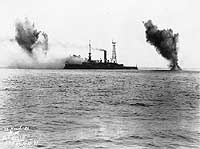
In mid-1919 the laid-up USS Coast Battleship No. 4 (which had been named Iowa until April of that year) was selected to become the Navy's first radio-controlled target ship. Conversion work, done by the Philadelphia Navy Yard, was completed in August 1920 and involved removal of all the ship's guns, installation of remote control equipment, fitting her after boilers to burn oil fuel, sealing of many compartments and installation of automatic pumps to control water that might be admitted when she was struck by gunfire or aircraft bombs.
In her new guise Coast Battleship No. 4 ran trials off Chesapeake Bay in October 1920, with the old battleship Ohio serving as control ship. Once the ship was gotten underway by a human crew and taken to the operations area, her people left in boats and the radio gear was used to control her steaming and maneuvers. Several months later, at the end of June 1921, Coast Battleship No. 4 was again laid up at Philadelphia while plans were made to employ her in fleet exercises. After being placed back in active service, in April 1922 she went to Hampton Roads, Virginia, to take part in gunfire exercises, this time with the minelayer Shawmut as control ship. However, nothing came of these plans and Coast Battleship No. 4 remained in port.
Early in 1923 the target ship finally went to sea and in February transited the Panama Canal to the Pacific, where she was to serve as a target for the battleship Mississippi's guns. With control from Shawmut and the minesweeper Quail standing by to perform necessary salvage and repair work, Coast Battleship No. 4 first was bombarded by five-inch secondary batteries, at ranges of some 8000 yards. Two further exercises, at longer range, placed her on the receiving end of more than three hundred fourteen-inch shells. The old ship sank in the Gulf of Panama after being hit by nearly three-dozen of these three-quarter ton projectiles.
This page features views concerning the former USS Iowa during her service as a radio-controlled target ship.
For other images concerning this ship, see:
| If you want higher resolution reproductions than the digital images presented here, see: "How to Obtain Photographic Reproductions." |
Click on the small photograph to prompt a larger view of the same image.
For other images concerning this ship, see:
| If you want higher resolution reproductions than the digital images presented here, see: "How to Obtain Photographic Reproductions." |
Page made 13 April 2003